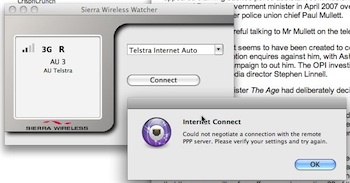Over the last few months, I’ve been trialling Telstra’s Next G mobile broadband as part of an experimental “technology seeding program”. Despite my initial doubts, I’ve been impressed.
Previously I’d been using Vodafone 3G, tethering my MacBook Pro via Bluetooth to a Nokia N80. It worked just fine. I subsequently moved to a Nokia N96 and Virgin Mobile, which uses the Optus network under the hood. It’s terrible. I made a big mistake.
But that’s a story for another time…
Sure, Next G is the most expensive mobile broadband out there. But it’s also the best. Clearly.
On our road trip, we could use Next G almost all the way from Cowra back through Bathurst to Sydney. Yes, the signal dropped out as we drove through hilly areas, as you’d expect. But the data link automatically reconnected once it found a new cell — with the same IP address!
Seriously. Here I was in a moving car, running a ping and watching YouTube videos. The link dropped out. It reconnected. And when it did, perhaps six minutes later when the terrain sorted itself out, the video started playing from where it left off. Pings resumed with the very next packet number in the sequence — albeit with ping times of over 370 thousand milliseconds.
In another test, the data link kept the same IP address while I caught a train from Newtown across Sydney Harbour to Pymble. In CityRail’s loop under the Sydney CBD, there was no signal in the tunnels, but the link came back up within seconds of arriving at a station.
Somebody did some great network engineering. They deserve a pat on the back.
But what else?
The Good:
- Next G is fast. My card was set to use HSUPA, i.e. increased upload speed at the expense of downloads. In central and inner west Sydney, I consistently got 6Mb/s download and sustained 1M/s upload. The network was nominally rated at 14Mb/s
- Coverage is good. As an example, we got a clean data link while 7km out of Cowra in a location where Vodafone was marginal and Hutchison/3 was dead.
- Dropouts were minimal. I could rely on being able to do sustained uploads or downloads.

The Bad:
- It takes two attempts to connect. PPP authentication usually times out on the first attempt. It’s usually fine on the second. But it is irritating.
- The Mac user interface is pig ugly and lacks vital features. This isn’t directly Telstra’s fault. Sierra Wireless, who make the card, need a good hard slap. There’s simply no excuse for not providing a full-featured Mac interface for a mobile product. Telstra, please make that a selection criterion!
- Occasionally, you’ll roam to 3’s network. There’s a peering agreement whereby 3 Mobile users roam to Next G cells when their own aren’t available — great outside the major cities. But the downside is that you can also roam off Next G to 3 if you’re closer to a 3 cell — as shown in the picture. Apparently you can turn off this feature by setting the card to only use Next G’s 850MHz frequencies — but that option isn’t available in the Mac interface, only Windows. The card is now stuck on 3 and I can’t change it back. Fail.
The Unknown:
- What’s the customer service like? I dealt directly with a Telstra market development manager, so I was spoilt. If you use Next G, do you also get Telstra’s traditionally-shitful customer service? I have no idea.
Yes, Next G is one of those cases where you get what you pay for. But if you want to actually use mobile broadband instead of swearing at it, it’s probably worth the cost.
Dear Optus, Vodafone and 3, if you’d like me to re-visit my opinions of your own products, I’m more than happy to give them a trial too. You know where to find me.


I too use the Telstra Next G network for work. I have a 5GB/month plan for $44.50/month for the first 12 months then $89/month thereafter, but who knows by then the price may have decreased. I use the 7+ Series USB modem (faster uploads) Some speed tests of its use on a typical train trip between the City & Blacktown can be found here http://blog.evansmith.info/?p=81
I also use a Mac and see the same PPP auth error you describe, not all the time though just every now and then. Come to think of it seems to happen if I did not properly disconnect the previous session. Anyway yes the Mac interface from Sierra wireless sucks balls, you can’t send/receive SMS messages (Telstra sends you one when you approach 80% and 100% of your quota) and there are many other features missing. For those that need to keep track of usage I find a little Mac app called SurplusMeter fantastic, it monitors the packets on the PPP connection and graphs your usage
Regarding the roaming onto the 3Telstra network, this happens on my iPhone and the data card. I had to put the data card into a Windows machine and set the firmware to 850Mhz mode to ensure it could only use NextG and not the 3Telstra (2100Mhz). This feature should be made available on the Mac. The iPhone does it sometimes too but I go in and manually select the ‘Telstra Mobile’ network rather than ‘3Telstra’
The unknown — customer service. I am on a business account with approximately 30 users and I am in charge of IT and thus the Telstra account. I can say the Telstra’s business support is outstanding! Whenever I have had any issues my call is answered straight away, if not then in less than 3 minutes. The staff are professional, know their products and issues well and have always been able to have my problems fixed on the first call. If they are unsure they have no trouble placing you on hold and finding out for sure what they are to do then resolving it, instead of stuffing you around hoping things work.
All in all I’m very happy with moving to Telstra. Our Vodafone customer service was absolutely shocking. Sure you pay a bit more for Telstra but it’s worth it in the end when you don’t need to spend hours on the phone to customer service. In the negotiations for moving accounts Optus was involved but their account managers didn’t seem too interested in getting our business.
Hi Stil,
How does it go with various types of streaming media: audio, video over various protocols like rtsp rtmp http etc?
@Fictillius: Thanks for all that. While it’s anecdotal, the joy of social media is that we can aggregate our anecdotes to form a coherent picture of reality, or some approximation thereof.
One important take-home from what you say: business vs residential accounts.
I’ve had clients complain that another ISP took 24 to 48 hours to respond to a support request. “I’m trying to run a business,” they whinged. And yet the cheap-arse plan they were on was clearly labelled “residential”. The same ISP had business plans with faster and better support. “But they’re more expensive,” they whinged. Well, yes. But by skimping on maybe $20 a month, they were without their Internet for two days — and lost thousands of dollars of business. Idiots.
@Fergus Pitt: I don’t really play much with streaming other than through HTTP (is that what YouTube etc use in their Flash thingies?). I found Next G to be reasonably stable here. In a static location, I didn’t notice anything problematic. While mobile, well, it all depended on how big the buffer was before a cell switched. I found it “acceptable” — but then I’m a patient soul when using bleeding-edge stuff.
How’s that for scientific analysis? 😉
I did do Ustream uplinks while on the move. Ustream say you need 400kb/s to get a reliable video stream. I could do that from a moving vehicle reliably enough — until, as I say, it switched cells.
I have to agree with you that Telstra’s NextG is far and away the best mobile data network. Even their old EV-DO network was better than Optus 3G!
I’m somewhat lucky as the plan I’m on really suits my usage patterns (and no longer available to new customers unfortunately). $29.95 per month for 10 hours. No speed or data limits. Additional time in 15 minute blocks. Useless for an always-on connection but great for the occasional email, web search and massive ISO/patch downloads.
Having migrated from the old EV-DO network the additional coverage outside metro areas was welcome. EV-DO did have country coverage but the speeds on CDMA was just as bad as GPRS.
It’s become one of those things that I wonder how I lived without. As a contractor who frequently ends up working outside my office the ability to jump on the Internet without having to worry about plugging in to someone else’s network or hunting for a analogue phone line is very handy.
It’s pretty clear that there are some very smart people at Telstra. As you said the engineering that went into this makes the other networks look really bad.
From memory customer service was still a bit average, although I haven’t needed to call them for a very long time so this might have changed.
FYI: Telstra wireless broadband customer service is horrible. So is that of Vodafone, 3 and Optus. Just pray you don’t have any problems. The technology works most of the time at the standards we are forced to accept. The POTS service on two wires is so much better but our lifestyles don’t allow us to sit on our backsides in one spot. The cost is exorbitant given that wireless is cheaper for Telcos to roll out than wired and the speeds are slower. Now the Federal Government is going to spend zillions on wired broadband when it should be looking at a national wireless infrastructure at an affordable cost to consumers and then provide universal wholesale access to retailers to provide mobile voice and data and video coverage at really good rates.
@Frank Filippone: I have to agree, the convenience of having your own known-good Internet connection, independent of whatever might exist at a client’s premises or any random café or pub, is invaluable. I haven’t used a dial-up account or even carried an Ethernet cable for nearly a year.
@Giuseppe De Simone: I’ve got to disagree with you about one thing: Australia needs a national hard-wired network. Yes, for all the reasons you and others have given, a mobile network is A Good and Useful Thing. But there’s applications for which is just simply isn’t suitable — like those demanding any kind of thoroughly-reliable low-latency data link.
Currently the most vocal of these more demanding users are gamers, so it’s easy to write off their “needs” as self-indulgence. Which they are. But applications are emerging, such as remote surgery using robots, where the last thing you need is the kind of electronic interference we get even in a heavily-populated like Enmore.
But yes, traditionally telco customer support is shitful. But then people want “cheap”, and providing quality support is a significant cost.